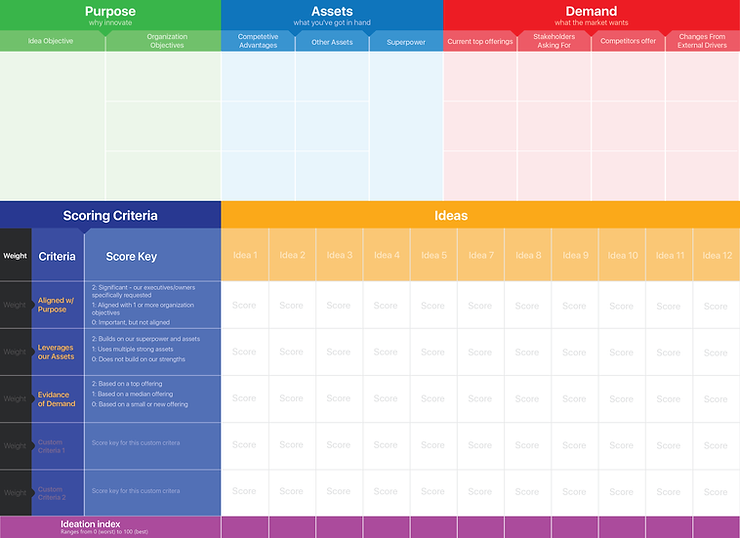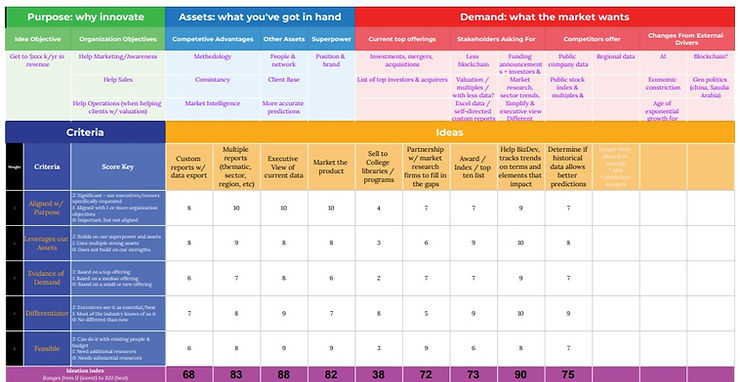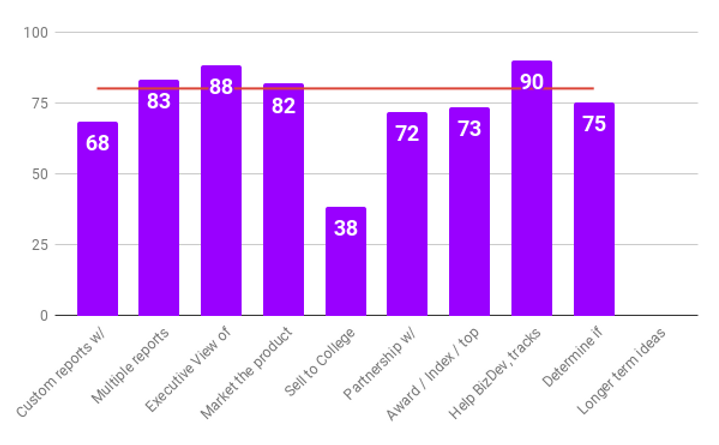
1. Problem
2. PixelEdge Solution
3. Create a team
4. Build the PAD
5. Identify and score the ideas
6. Innovation example
7. PAD
Purpose: Why innovate?
Assets: What you’ve got on hand
Demand: What the market wants
8. Identify and score ideas
Criteria
Ideas
Voting
9. Result
A leading data aggregator for an entertainment sector came to PixelEdge to help maximize one of their offerings. The team knew that they had a wealth of data that helped them make deals for their clients, and they sold this data to companies in their space.
It was clear that there was more opportunity for their research and data products, but they wanted to invest their resources in promising ideas for their target market. The product was useful to their business as a marketing and operations tool, but they wanted to build it into something more.
They decided to call Paul Silva at PixelEdge to see if he could help them identify market opportunities for this underutilized data. He could look at the information and infrastructure they had, help them define goals, and walk them through a structured process to find the most effective ideas to pursue.
The client had deep experience in their industry, but they knew they wanted some outside guidance on ideation for their data aggregation tool. To find ideas that would get off the ground, they needed to first establish a solid launchpad.
Paul Silva built the IdeaPAD during years of working with students and companies in innovation and entrepreneurship. The IdeaPAD helps a team identify potential ideas based on its goals, resources, and market, all with only a single page of prompts in a day or less. The prompts then lead to a brainstorming session for team members, and a scoring system allows the best potential ideas to come together. Previous companies using the IdeaPAD scaled their product by 10x or became leaders in their space.
To use the IdeaPAD for your company:

The IdeaPAD works best with a good mix of team representatives from two categories:
Bring together all team members to work through the IdeaPAD prompts with a neutral facilitator.
The PAD (“launchpad”) allows you to come up with a firm foundation for the ideas you’ll brainstorm later. It covers what you are hoping to achieve (the Purpose), what you already have that can help (the Assets), and whether there is already evidence that there is a need in your market (the Demand).
The facilitator works through the prompts with the team to build the PAD, as outlined in the table below.
After your team really understands its PAD, it’s time to brainstorm ideas, score them, and decide which ideas are the best candidates for launch.
The entertainment data client that approached PixelEdge already had data and technology. They had an investment information tool for their space, including research and data analysis. Their customers liked the tool, but the company had not made this resource a priority and wanted to unlock its potential.
They brought together a team that included two company leaders, the product leader, and two data analysts who worked on the project. This team was a good mix, including people who defined strategy and allocated resources along with those who worked closely with the data. Paul Silva then facilitated the discussion.
The company representatives knew that they had amassed the best data in the business and wanted to tap its potential. Without a clear objective, however, it is difficult to succeed. Paul prompted them with questions about whether they wanted more revenue, subscribers, or visibility in their space.
The existing product already improved marketing and sales by raising their credibility in the entertainment sector. It also helped their operations team by providing strategic data directly to their clients. As it was originally envisioned as a marketing and sales tool, it was currently a cost center. While they have ambition for the product to grow to have a significant impact, the team leader smartly decided to go for iterative improvement and decided to focus on growing its revenue enough to cover its hard costs.
Once the team leader decided on that goal, they also defined their purpose to include the organization's objectives of marketing, sales, and operations.
From there, they looked at their assets and discovered that they are well positioned for growth based on their current market position in the industry. They have great internal resources and a large external network to work with.
In short, their superpower is their position and brand in their industry. They recognized that they are the top company of their kind in the world and that their team has personal relationships with the industry’s most important players. This potential superpower was being used in other parts of their company, so they realized they could apply it to an idea for this product to reach their revenue goals.
They then reviewed the demand:
Now that they had their PAD (and took a lunch break), they were ready to start brainstorming ideas for what they could do next.
Along with the default scoring criteria, which includes scoring against the Purpose, Assets, and Demand (PAD), they included the following additional criteria:
Each criterion was weighted at either a 1 or 2, though any multiplier could be used. Since the company wanted to reach low-hanging fruit, they weighed the feasibility category at 2.
From here, they brainstormed several ideas to increase interest in the tool and wrote them on Post-it notes. They each picked their best ideas, put them on the board, and gave a brief introduction to everyone as they posted them.

The team members had a few minutes to secretly score each idea against the five criteria. Paul then tabulated and compared the results.
With Paul facilitating the discussion, he first checked scores to see if some scored a 0 (lowest) versus others a 2 (highest). When someone’s idea scored poorly, there was a quick, respectful discussion, and then the idea was put to rest.
Some interesting discussions came out of the low-scoring results:
And the discussions for the best-performing ideas were exciting:
Some of the longer-term, bigger ideas were tabled and left unscored, because it was clear that, while those could be valuable in the future, they would take a lot more thought and assets than the company was willing to provide versus its current purpose of increasing short-term revenue.
At the end, they had a chart of ideas and could clearly see a few winners with total scores over 80 that made the most sense to the whole team. They were excited to see that the best ideas both built on their strengths and were reasonable to achieve.

The team lead selected two of the ideas, and Paul assigned them additional tasks:
The client spent a single day with PixelEdge to build their PAD foundation and develop ideas. At the end of the workshop, they had clear objectives for moving forward with the best prospects, and they had already assigned team members to do the work. Best of all, they were excited by the opportunities to leverage their superpower and achieve their goals.
As the Business Information Director at the client said:
Determining if a product has a market opportunity is a tricky process. [PixelEdge] helped us evaluate our offerings internally to decide what is important to us as a company as well as which products are within our wheelhouse, feasible and easy to integrate into our process, and of value to our customers.
If you would like a guided IdeaPAD workshop like the one featured in this article:
If you want to use the IdeaPAD yourself, the template is licensed under Creative Commons, which means you may use or modify (with attribution) it freely:
Google sheet Printable poster Image for digital whiteboards
Paul Silva would like to give a huge thank you to:
